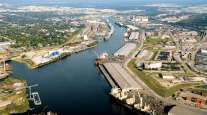Senior Reporter
BYD to Deliver Electric Trucks to Southern California Facilities

This story appears in the March 20 print edition of Transport Topics.
Electric vehicle maker BYD Motors Inc. will deliver 27 battery- electric medium- and heavy-duty trucks to freight facilities in smog-ridden Southern California in a deal that is supported by state grants but is meant to prompt much broader commercialization, BYD said.
Three Class 8 yard trucks and one Class 5 service truck will operate at less-than-truckload carrier Daylight Transport’s new LEED-certified, resource-efficient terminal in Fontana, California, beginning this month. Also, two BNSF Railway yards in San Bernardino and Los Angeles counties will take delivery of the remaining 20 Class 8 yard trucks and three medium-duty vehicles in the coming months, according to the vehicle maker, which is headquartered in China.
BYD is the world’s largest electric vehicle manufacturer of both consumer electric and commercial or industrial vehicles, the company said.
“A lot of people have tried to do electrification in the past, but they have tended to be smaller compa- nies. BYD is a large, well-capitalized, global original equipment manufacturer, and we have the experience, having done this in different industries, that we know how to bring product to market,” Andrew Swanton, BYD’s vice president of truck sales, told Transport Topics.
Yard trucks operate continually at ports, rail yards and warehouses that often are located within or adjacent to disadvantaged residential areas, BYD said. The service trucks are used to service all of the cargo- handling equipment at freight facilities, including yard trucks.
This project was funded in part by California’s cap-and-trade program, BYD said.
“There is no cleaner technology. We think, through the demonstration projects, we will also be able to document the ease of maintenance, the driver comfort, the lower total cost of ownership and the longevity of the electric motors,” Swanton said.
BYD also will be involved this year in a pilot project involving 25 Class 8 drayage trucks at the ports of Los Angeles, Long Beach and Oakland.
Daylight Transport, thanks to state funding, got a deal on the yard trucks. The Long Beach, California, company ranks No. 22 on the Transport Topics sector list of top less-than-truckload providers.
It could have paid BYD about $300,000 each for the yard trucks. That would have been about three times as much a comparable diesel- fuel model costs. But a California Climate Investment Program grant eliminated out-of-pocket cost, Day- light Executive Vice President Greg Steele told TT.
At the same time, “We decided to buy 40 electric forklifts from BYD and then power them all from our 600-kilowatt solar system,” Steele said.
Steele said the location of the company’s new terminal in a residential neighborhood with poor air quality was a key reason it got involved in the project.
BYD is largely a vertically integrated company when it comes to truck making.
It manufactures trucks at its facility in Lancaster, which is in Los Angeles County. Its North American operations are based in Los Angeles. It produces the propulsion components, batteries, frames and axles. But it uses locally sourced suppliers for things such as lights, braking systems and mirrors, Swanton said.
The trucks are powered by the company’s lithium iron phosphate [FE] batteries, and Swanton said the most advantageous aspect of those batteries is that they last a long time.
The yard trucks have 225 individual batteries, each one is 16.4 inches × 5.7 inches × 2.2 inches with a weight of 14.37 pounds each, or 3,236 pounds total, the company said.
In its transit operation, BYD warrants its batteries for 12 years. “None of our competitors are willing to go that high,” he said. “In fact, most of them are at five years.”
The baseline warranty for all truck deployments is five years or 150,000 miles, although extended warranties are negotiable, BYD said.
Meanwhile, BYD is looking for other states and cities to lead the way into commercialization.
“Truthfully, we need some leadership from government, but within about a five-year timeframe, if we can get enough demand to get our volumes up, we should be cost-competitive,” Swanton said. He pointed to the need to also achieve manufacturing scale and have the “general market” for batteries bring the price of them down.
New York City, Chicago and Washington state and New York state, were likely areas where the zero-emissions applications could take root, he said. “They could lead the charge. We are looking basically at every class of vehicle and every application that makes sense.”
BNSF did not respond to a request for comment.



